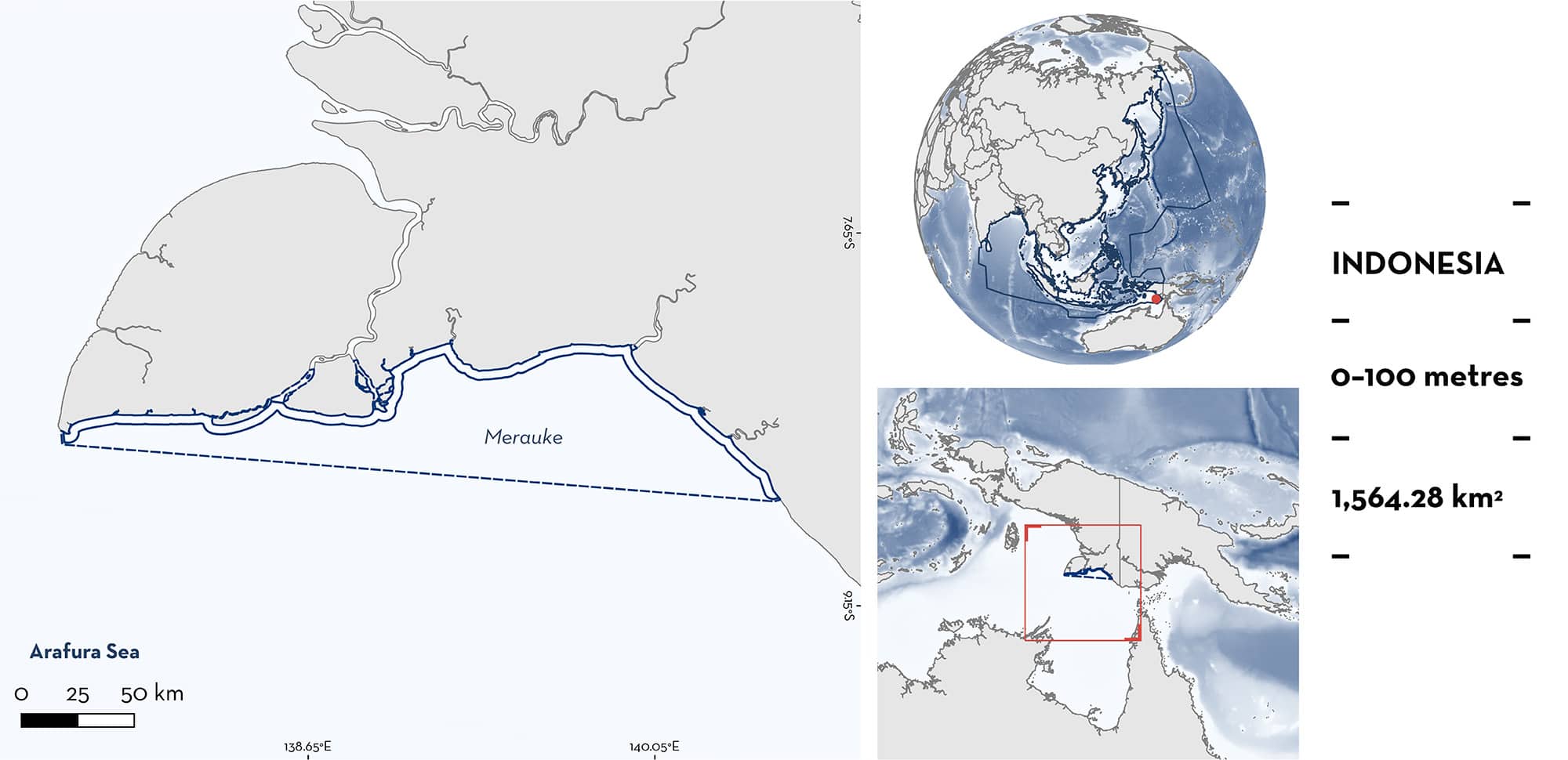ISRA FACTSHEETS
ISRA FACTSHEETS
ASIA REGION
Merauke
Summary
Merauke is located in Papua, Indonesia. The area extends from around the Merauke River mouth to Sabon on Dolok Island. It is characterised by mangrove forests, and sandy and muddy substrates. It is influenced by freshwater influxes from many rivers. This area overlaps with the Kaimana and the Kolepom Island marine protected areas. Within this area there are: threatened species (e.g., Largetooth Sawfish Pristis pristis), and reproductive areas (e.g., Narrow Sawfish Anoxypristis cuspidata).
Download factsheet
Merauke
DESCRIPTION OF HABITAT
Merauke is located in the Merauke Regency in the Indonesian Province of South Papua. It extends from around the Merauke River mouth on the mainland, to Sabon which is situated on the southeast coast of Dolok Island (separated from the mainland by the Muli Strait). The area encompasses estuarine and coastal habitats and is characterised by mangrove forests, and sandy and muddy substrates.
Merauke is influenced by freshwater influxes from rivers (Lantang et al. 2023) including the Maro, Kladar, and Bian rivers. This may be further affected by the high precipitation which influences the area during the wet monsoon season (Supriyadi et al. 2017). In general, Indonesia is generally exposed to strong winds, however the ocean wind speed in this area is weaker than in the adjacent waters of Flores, Moluccas, Papua, South Kalimantan, and West Java (Purba et al. 2015).
Merauke overlaps with the Kaimana marine protected area (MPA; Protected Planet 2024), and the Kolepom Island MPA (ATSEA 2024).
This Important Shark and Ray Area is benthopelagic and delineated from inshore and surface waters (0 m) to 100 m based on the depth range of the Qualifying Species in the area.
CRITERION A
VULNERABILITY
Two Qualifying Species considered threatened with extinction according to the IUCN Red List of Threatened Species regularly occur in the area. These are the Critically Endangered Narrow Sawfish (Haque et al. 2023) and Largetooth Sawfish (Espinoza et al. 2022).
CRITERION C
SUB-CRITERION C1 – REPRODUCTIVE AREAS
Merauke is an important reproductive area for two ray species.
Narrow Sawfish regularly occur in the area, with records as recent as 2021 (Sawfish Indonesia unpubl. data. 2024). There are at least 21 contemporary records (since 2009) of Narrow Sawfish in Merauke. This is the largest cluster of contemporary Narrow Sawfish records in Asia. Specific size classes of individuals caught within the area are not available, although photographs provided by fishers indicate they are young-of-the-year and juveniles based on their estimated total length (TL). Published size-at-birth for this species is ~43–70 cm TL (Peverell 2009; Dulvy et al. 2016; Last et al. 2016) and this species is noted to approximately double in size during the first year of life (Adkins et al. 2016). Narrow Sawfish were observed caught in the area in 2009 (Domande Beach, n = 1), 2010 (Ambon, n = 3), between 2014–2018 (Kimam, n = 3), 2017 (Merauke, n = 2), 2018 (Domande Beach, n = 1), and 2021 (Lampu Satu, n = 3; Kimam, n = 1 juvenile measuring <100 cm TL; Maro River, n = 7 neonates from a small fishing boat). Recent gillnet fishery surveys in the area found that small Narrow Sawfish regularly occur in local estuaries and shallow coastal areas (Silalahi et al. unpubl data). Local ecological knowledge indicates that fishers catch small Narrow Sawfish in these areas, although the number of captures has decreased since 2010 (Silalahi et al. unpubl data). The presence of the species in the area is also supported by historical catch records such as two individuals caught from Muara Savan in 1997, and one from Kimam in 1997 (Sawfish Indonesia 2024). The importance of this area for reproductive purposes may be seasonal given the observation of seven neonates in February 2021, which is within the rainy season (November to March) (Prehadi pers. obs. 2024). This area has high regional importance as it is the only known area in Asia with regular contemporary Narrow Sawfish observations.
Largetooth Sawfish regularly occur in the area, with records as recent as 2020 (Sawfish Indonesia 2024). There are at least seven contemporary records (since 2009) of Largetooth Sawfish in Merauke. This represents the largest cluster of contemporary Largetooth Sawfish records in Asia. Specific size classes of individuals caught within the area are not available, although photographs provided by fishers indicate they are young-of-the-year and juveniles based on their estimated TL. Published size-at-birth for this species is 72–90 cm TL (Peverell 2009). Largetooth Sawfish were caught in the area in 2009 (Pantai Lampu Satu, n = 1; Pantai Payum, n = 1), 2013 (Perairan Pulau Habe, n = 1), and 2020 (Sungai Bian, n = 1; Muara Bian, n = 1; Muara Kladar, n = 2). Recent gillnet fishery surveys in the area found that small Largetooth Sawfish regularly occur in local estuaries and shallow coastal areas (Silalahi et al. unpubl data). Local knowledge information indicated that fishers catch small Largetooth Sawfish in these areas, although the number of captures has decreased since 2010 (Silalahi et al. unpubl data). The presence of the species in the area is also supported by historical catch records such as one individual caught from Lupa in 1997 (Sawfish Indonesia 2024). This area has high regional importance as it is the only known area in Asia with regular contemporary Largetooth Sawfish observations.
Download factsheet
SUBMIT A REQUEST
ISRA SPATIAL LAYER REQUEST
To make a request to download the ISRA Layer in either a GIS compatible Shapefile (.shp) or Google Earth compatible Keyhole Markup Language Zipped file (.kmz) please complete the following form. We will review your request and send the download details to you. We will endeavor to send you the requested files as soon as we can. However, please note that this is not an automated process, and before requests are responded to, they undergo internal review and authorization. As such, requests normally take 5–10 working days to process.
Should you have questions about the data or process, please do not hesitate to contact us.


